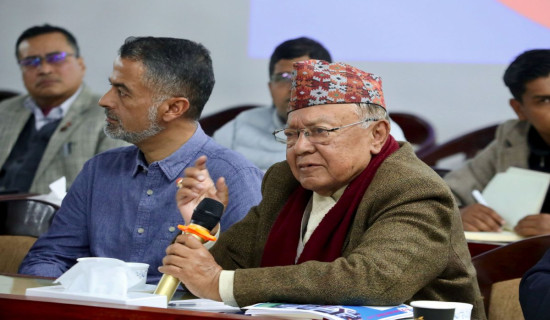- Monday, 22 December 2025
Nepal’s Myriad Of Challenges
How Can They Be Addressed?
Nepal, as an underdeveloped nation, has been facing myriad of problems. One of the major problems, which it currently confronts is- many Nepali citizens are migrating abroad looking for a better lifestyle. Hordes of youths, well established professionals such as doctors, engineers, teachers, nurses, young students, and many others are leaving the country. What do our people hope to get abroad that Nepal does not? There are couple of factors that drive Nepalis’ migration abroad:
Economic reasons: Since Nepal is still growing and offers few economic prospects, many Nepalis may leave to escape poverty and raise their standard of living.
Better job opportunities: Nepalis move abroad in pursuit of more lucrative employment. This is especially true for people with technical expertise and advanced degrees, who may have trouble securing acceptable employment in Nepal.
Political instability: For many years, there has been political instability in Nepal, which has made the country's residents' lives unpredictable. Some people might decide to leave the nation to escape the instability and look for a more secure life abroad.
Education: Nepalis move abroad to pursue higher education opportunities that may not be available in Nepal.
Social maltreatment: Due to social persecution, such as discrimination, harassment, or threats to their safety and security, Nepalis may be driven to leave the nation.
Migration of Nepali citizens overseas reflects the opportunities and difficulties they encounter on a daily basis. While migration can open doors for people and their families, it also highlights the need for Nepal to address the underlying problems that cause migration. This includes increasing job opportunities, addressing political instability and corruption, and making investments in infrastructure and education to build a more prosperous and stable society.
Nepal, a landlocked nation in South Asia, has faced numerous challenges throughout its history. The social, economic, and political structures of the nation, as well as the welfare of its citizens, have been significantly impacted by these crises. Natural catastrophes like earthquakes, floods, and landslides, political unrest, armed conflicts, and health crises like the COVID-19 pandemic are just a few of the crises Nepal has experienced.
These crises have challenged Nepal's ability to respond effectively, highlighting the need for preparedness, resilience, and effective leadership. In this context, the government, civil society, and international partners have played critical roles in mitigating the impact of these crises and supporting the recovery and reconstruction efforts. This article aims to examine some of the national crises that Nepal has faced, their causes, impacts, and the response measures taken. Additionally, it aims to discuss the lessons learned and the way forward to build a more resilient and sustainable Nepal.
Like many developing countries, Nepal faces various financial challenges that impede its economic growth and development. Addressing these challenges will be critical for Nepal to build a more prosperous and stable society for its citizens. The problems which affect its capital are:
Corruption: Corruption is prevalent in Nepal's public and private sectors, resulting in a loss of revenue and inefficiency in public service. This problem has hindered foreign investment and donor support, and the government needs to implement measures to combat corruption and promote transparency and accountability.
Trade deficit: Nepal imports more goods than it exports, resulting in a trade deficit. This imbalance affects the country's balance of payments, currency stability, and foreign exchange reserves.
Limited sources of revenue: Nepal's economy heavily relies on remittances, tourism, and agriculture, which are vulnerable to external shocks and fluctuations. The country lacks diverse sources of revenue, which hampers its capacity to fund social and infrastructure development.
Limited access to finance: Access to finance is limited for many Nepalis, particularly those in rural areas and from marginalized communities. This limits their ability to start businesses, invest in education, and improve their livelihoods.
Inefficient tax system: Nepal's tax system is characterized by a low tax base, a narrow tax net, and high compliance costs, leading to low tax collection rates. The government needs to implement effective tax policies and administrative measures to increase its revenue collection.
It will need considerable legislative changes, institutional improvements, and investments in infrastructure, education, and technology to solve these financial issues. For Nepal to strengthen its financial stability and achieve sustained economic growth, the government must work together with the business sector, civil society, and international partners.
Although Nepal does permit dollar transactions, there are some limitations because of the nation's foreign exchange laws. The Nepalese government controls the exchange of foreign currency to stop capital flight, manage inflation, and maintain the stability of the nation's financial system.
One of the limitations is that without prior authorization from the central bank, Nepali citizens are not permitted to keep or carry more than USD 5,000 or its equivalent in other foreign currencies. This cap is in place to stop unlawful actions like money laundering or financing for illegal activities.
Another restriction is that foreign exchange transactions over a particular threshold be conducted through authorized dealers, including banks or registered money changers. This provision is in place to make sure that all transactions involving foreign currency take place through authorized channels and that the nation's foreign exchange reserves are adequately managed.
Altogether, Nepal's dollar transaction limitations are in place to protect the integrity of the nation's financial system and to deter illicit activity. These limits may make it more difficult to transact in foreign currencies, but they are vital to safeguard the nation's economic interests and guarantee financial stability. However, if Nepal's financial situation were to improve, these restrictions would be eased or eliminated altogether in the future.
The government of Nepal should focus on education too, so that students do not need to go abroad for studies and providing placement for jobs to secure the future of graduate students. The government should make the students trust their education establishments. The estimated expense for education abroad is 35.5 billion rupees (2022-2023), which is increasing compared to previous years.
Nepal has the potential to overcome its limitations and rise as a nation. One of its primary resources is the flowing water from the Himalayas, which is already used as a tourist attraction. This resource can also be utilized to generate electricity by building hydroelectric plants in suitable locations. Although many projects for building such plants are still under construction, they aim to produce a total of 8184 MW (as of September 2022). If these projects are completed and the targeted quota is met, Nepal will have surplus energy, which it can export to generate revenue and improve its economy, contributing to the country’s development.
Water Resources
Hydroelectricity is a reliable and renewable source of energy that is only dependent on flowing water to generate electricity, unlike other sources that rely on multiple factors. Therefore, Nepal can leverage this resource to its advantage and develop its infrastructure for hydroelectricity to meet its energy needs and promote economic growth. The surplus energy produced can be exported to neighboring countries, generating more revenue and boosting Nepal's economy further. By focusing on this sector, Nepal can increase its energy production and generate revenue, contributing to the country's growth and development Here are other benefits of a Hydroelectricity plant:
Clean and emissions-free: Hydroelectricity is a clean energy source since it generates no emissions or pollution while producing electricity. It is therefore the best choice for nations aiming to lower their carbon footprint and achieve their emission reduction goals.
Multipurpose use of water: Nepal also being Hydroelectric power plants can also serve other purposes besides power generation, such as irrigation, flood control, and water supply. This makes hydropower a versatile and flexible resource that can help meet multiple needs in a region.
Low operating costs: Compared to other types of power generation, hydroelectric power plants have minimal operational expenses. Hydropower is a cost-effective form of energy because, beyond the initial expenditure in establishing the power plant, there are no fuel costs involved in producing electricity from it.
Reliable Source: Unlike other renewable energy sources like wind and solar electricity, which are sporadic and depending on the weather, hydroelectric power facilities are dependable and may run continually. Due to its ability to deliver a steady supply of electricity and satisfy the baseline level of demand for electricity, hydroelectricity is the best source of base-load power. Using electricity as a primary source of energy can also help the country to lower carbon emissions which contributes to improving health in the country and the world because pollution is not country locked.
Hydroelectricity and electric cars are connected in several ways. Hydroelectricity is a clean and renewable source of energy that can be used to power electric cars, which are becoming increasingly popular due to their lower carbon emissions and reduced dependence on fossil fuels.
Electric cars use batteries to store energy, which can be charged using electricity from a variety of sources, including hydroelectricity. Hydroelectricity can be used to generate the electricity needed to charge electric cars, making them a more sustainable mode of transportation compared to gasoline-powered cars.
Going Electric
In addition, the growth of electric cars has the potential to create new opportunities for hydroelectricity. As more electric cars hit the road, demand for electricity will increase, and hydroelectricity can play a vital role in meeting this demand. This can help stimulate investment in hydroelectric projects and support the growth of the industry.
The relationship between hydroelectricity and electric cars is a positive one, as both can help reduce carbon emissions and promote sustainable development.
It is important to replace the currently used gasoline cars to electric cars as this can have multiple benefits, but it requires a long and complicated process, such as the steps:
Setting thresholds: The government should establish challenging goals for the percentage of new automobiles sold that are electric and the number of electric vehicles on the road. Based on an evaluation of the nation's current energy infrastructure, vehicle fleet, and market conditions, these goals should be set.
Collaborate with stakeholders: To create regulations that encourage the expansion of electric vehicles, the nation should work with a variety of stakeholders, including automobile manufacturers, energy providers, and consumer advocacy organizations.
Incentives: The nation should offer incentives to entice people to switch to electric vehicles. To lower the cost of electric vehicles, this can involve tax breaks, financial aid, or other rewards.
Encourage innovation: The government ought to support developments in battery and charging infrastructure, as well as other aspects of electric vehicle technology.
Provide education and training: To aid consumers, mechanics, and other stakeholders in understanding the advantages of electric automobiles and how to operate and maintain them, the country should offer educational and training programs.
Build charging infrastructure: To promote the expansion of electric vehicles, the nation ought to create a network of charging stations. This could include both privately owned charging stations in residences and offices as well as publicly accessible charging stations in parking lots, retail establishments, and other public spaces.
The process of replacing gasoline cars with electric ones requires a comprehensive and collaborative approach that involves multiple stakeholders and policy levers. By taking these steps, a country can help accelerate the transition to a cleaner and more sustainable transportation system.
Another problem Nepal is facing is the traffic congestion, in fact it is famous notoriously especially in Kathmandu. A suggestion would be to build electric trains within the country for faster, cleaner, and more efficient transportation for passengers and luggage. The reasons for building electric trains are:
Set regulatory standards: To guarantee the efficiency, effectiveness, and environmental impact of electric trains, the nation should establish regulatory criteria. This might cover requirements for emissions, security measures, and battery and other component disposal procedures.
Efficient transportation: Electric trains can transport plenty of people in an efficient manner, which can ease traffic congestion and shorten overall travel times.
Cost-effective: Electric trains are more economical than other forms of transportation like cars and airplanes because they use less fuel and require less upkeep.
Boost to the economy: Investment in electric trains can lead to the creation of new jobs, especially in the construction and operation of the train system.
However, investing in electric trains requires a significant investment in money as well as a long-term outlook. The government would have to determine whether such a project was feasible and create a thorough strategy for building and running the railway system. Transportation is a demanding issue because Nepal imports fuel that is estimated to be 320 billion rupees. With this much money going out of the country, it is surely to affect the economy of Nepal which is why electric transportation and focus on hydroelectric projects are critical.
Nepal faces several challenges in developing its economy and improving the standard of living for its citizens. One significant issue is the low wages and salaries paid to workers in various fields. This situation is partly due to the country's limited economy and poor infrastructure, but the government has established a minimum wage limit.
Low Wages
As of August 2021, the minimum wage for unskilled workers in Nepal is NPR 15,000 per month, which is approximately USD 115. However, it is essential to note that Nepal's minimum wage is low compared to other countries, and many workers still earn less than the minimum wage due to weak enforcement and informal employment practices.
One way to address this issue is to create more job opportunities in fields where there is a demand for skilled workers. By doing so, the unemployed can find work, and the increased competition for labor will push wages and salaries upward. Another solution is to increase salaries without impacting profits, which will reduce tax evasion rates. With reduced tax evasion, the government will have more funds to use for the country's interests rather than personal luxury.
In conclusion, Nepal's economy faces several challenges, but the government can develop economic strategies to address them and move towards becoming a self-sufficient nation. While the solutions provided in this article may not solve all the issues, they provide a general concept that could be adapted to address other challenges.
(Karki is a software student)



-original-thumb.jpg)













